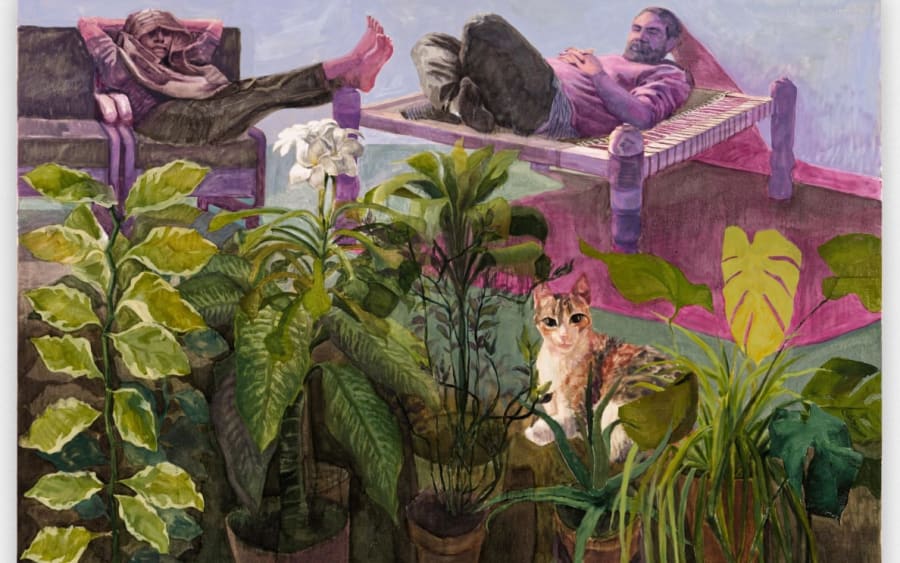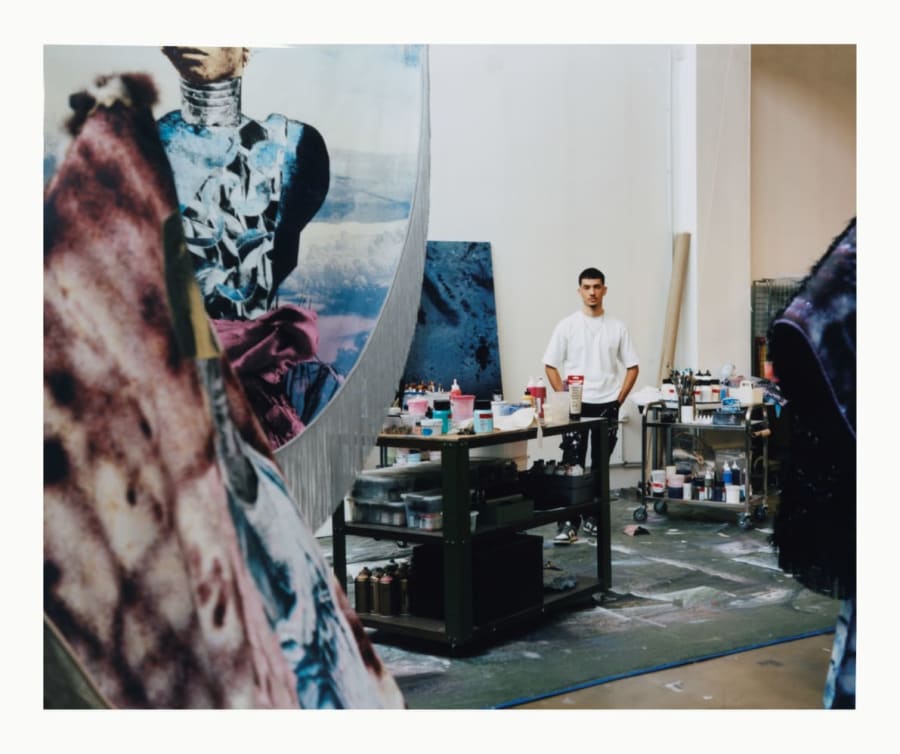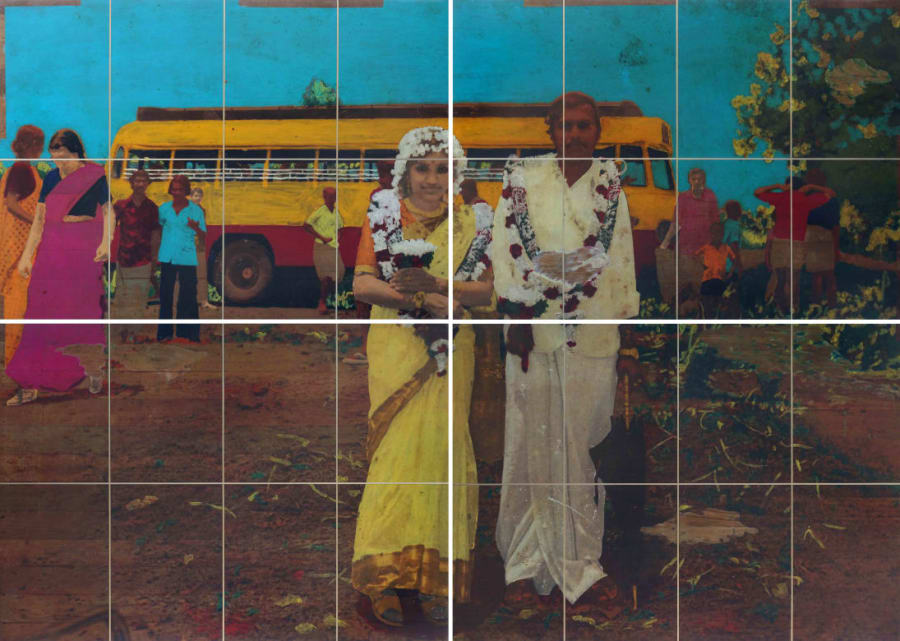When she lived in California, Huguette Caland would sometimes ring her daughter, Brigitte, who lived nearby, and say, ‘The poppies are blossoming in the desert – shall we go?’ The pair would then drive north – with a jazz soundtrack – to the state-protected Antelope Valley California Poppy Reserve; Caland would step out and walk around for a few minutes and they would head back to Venice, where the Lebanese artist lived and worked between 1987 and 2013. ‘We once did all of the north of Syria in 10 days,’ recalls Brigitte of her mother’s spontaneity. ‘She didn’t step out of the car; I’d go down and tell her what I saw, she’d draw it and pass it on to me. I miss it because the complicity was fun.’ Some of these impromptu drawings feature in the late artist’s first European retrospective, ‘A Life in a Few Lines’, opening at Madrid’s Museo Nacional Centro de Arte Reina Sofía on February 19.
It is such a great exhibition title for Caland, whose entire body of work began with a line. ‘The line is beautiful…I’m a line person,’ she says in a film shown at her first solo show in the UK, at Tate St Ives, in 2019. This focus on the line stems from Caland’s days at the American University of Beirut (AUB) following the death of her father, Bechara El Khoury, Lebanon’s first president post-independence, in 1964. By then, she was a married woman in her 30s and a mother of three, and having pursued a degree in law, was really keen on a life in art. The line went everywhere in her practice: across delicate drawings, paintings on linen, canvas, and panel. One of the techniques she was taught at AUB involved continuously drawing from the top of the page through to its end. Many of Caland’s works made in Beirut in the 1960s echo this practice: it is in the kisses, noses, and mouths rendered in minimal lines.
Caland’s relationship with the body began with a challenging rapport with her own: she had been overweight since childhood, which went against societal norms for what defines beauty. It did not help that she was the only daughter (and youngest child) of the president of Lebanon. She was expected to perform – and behave. Yet she had always been a bit of a rebel: falling in love and marrying Paul Caland, the nephew of her father’s political rival, having open adulterous relationships, making erotic work in a Beirut whose cultural milieu – while ‘golden’ in the 1960s and early 1970s – was still defining a woman’s place. If that was not all, in 1970, Caland boldly moved to Paris, leaving behind her husband and children, to pursue a career in art. There, she felt free at last.
It was in Paris that she began making kaftans (they were stylish and comfortable, and fitted her perfectly), and went on to design an haute couture line for Pierre Cardin. Caland made others – many of which were shown alongside drawings at Christine Macel’s 2017 Venice Biennale, ‘Viva Arte Viva’ – her erotic lines mirrored in cloth and paper. Her best-known series, the ‘Bribes de Corps’ paintings, are rendered in large expanses of bright, happy color, and feature curved and voluptuous shapes that could pass as abstracted landscapes. They seem innocent enough, only until a gluteal cleft, testicles, or vaginal lips can be spotted.
The ‘Bribes de Corps’ series is also how Hannah Feldman was introduced to Caland. The curator of Reina Sofía’s ‘A Life in a Few Lines’ had seen Caland’s work before at Jane Lombard Gallery in New York in 2014, but it was not until she attended a lecture by Dr. Omar Kholeif, (now the director of collections and senior curator at Sharjah Art Foundation) at the University of Chicago in 2016 in which he showed an image of Caland’s Self-Portrait – an oil on linen painting of, well, a giant pink bum – that she found the connection. ‘Huguette found me when I needed her. I needed to rediscover beauty, playfulness, and joy in artwork,’ says Feldman, who knew Brigitte from her research in Lebanon, went on to consult for Caland’s show at The Drawing Center in 2021, and headed to Beirut, where she met a then-frail Caland. Then came the Museo Reina Sofía’s invitation to curate Caland’s retrospective, Spain’s first. Like Brigitte, Feldman is hoping the show will shed light on lesser-known series, or in her words: ‘not just the libertine and cosmopolitan, but rather, those that explore the experience of diaspora, loss, movement, selfhood, collectivity, and even age, not to mention her roots in Lebanon, her interest in Palestinian tatreez (embroidery) and also, her curiosity about Phoenician and Byzantine visual culture and lettered forms.’
Feldman, whose show will follow a chronological order ‘with some interruptions,’ is all too aware of the delayed appreciation of modernists from the Arab world and Iran, but delighted all the same with the attention that Caland’s work has been receiving in recent years. In December, Mennour gallery in Paris staged an exhibition in collaboration with her estate showcasing almost 50 works that Caland produced in Paris. None were for sale, and some of those will be exhibited across 12 galleries at the Museo Reina Sofía alongside loans from Tate Modern, the Metropolitan Museum of Art, Los Angeles County Museum of Art, Museum of Modern Art, New York, the British Museum, and other public and private collections around the world. The Israeli military’s invasion of southern Lebanon last October and subsequent bombing meant that 33 works could not be shipped from Beirut to Madrid. Feldman plans to reincorporate 29 of those in the show’s next stop at the Deichtorhallen Hamburg that opens on October 24.
There could have been more material to include, another round of revisions to the hefty catalogue. ‘The toughest thing has been accepting that there had to be limits,’ says Feldman of the exhibition that presents about 300 works – some of which had to be restored. From interviewing studio assistants, family members, friends, and others who knew Caland, Feldman says the chats all felt ‘fated’ and that ‘there’s a certain sensibility to her work that is so transformative.’ There will be a lot of literature on Caland too – in addition to a museum catalogue, there is one that Mennour is publishing on its recent show, alongside others by Brigitte and Kholeif. Feldman is also curating another exhibition of Caland’s work that opens at the Arts Club of Chicago in April, along with another catalogue. An online catalogue raisonné is also in the pipeline, but because its subject was a life-loving, gift-giving artist, there are many works whose locations are unknown.
Brigitte recalls her mother’s lunches in Beirut that would bring together the cultural intelligentsia. Caland’s Madrid show will do the same, gathering her studio assistants from California, Beirut gallerist Nadine Begdache, Shirine Nakhal of Galerie Janine Rubeiz, beloved family and friends, and a whole new audience that will no doubt be inspired by an artist who was bold, adventurous, and hungry for life. ‘I love every minute of my life,’ Caland once said. ‘I squeeze it like an orange and eat the peel, because I don’t want to miss anything.’
Huguette Caland
‘A Life in a Few Lines’
From February 19 to August 25, 2025
Museo Nacional Centro de Arte Reina Sofía, Madrid
For over two decades, Myrna Ayad has written and edited for books, magazines, and dailies on visual art and culture from the Arab world and Iran. A frequent panelist, jurist, and moderator, her role as an independent cultural strategist allows her to work on projects for the luxury sector, government entities, private companies, and non-profit organizations.
Top image: Huguette Caland, Espace Blanc II, 1984. Courtesy The Estate of Huguette Caland and Mennour.
Published on February 13, 2025.


